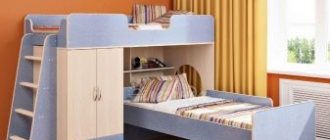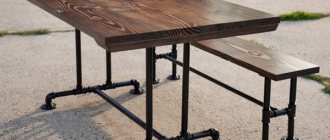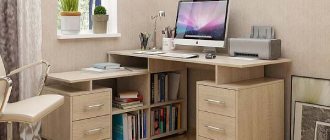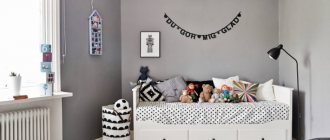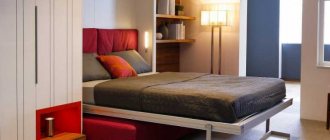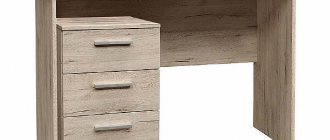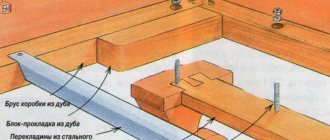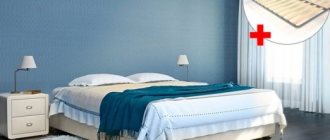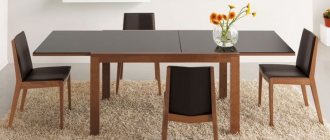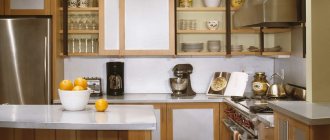Standard table sizes for a child
Manufacturers make products standard, so the sizes even for different models will be similar.
There are standards for choosing a chair for a child.
This is primarily due to state standards for children's furniture, which clearly regulate these issues.
If the design is chosen for a child under five years old, you should pay attention to models with a limiter.
The parameters are specified in detail in GOST 11015-93 and are valid in Russia, Kazakhstan and Belarus. In the international classification, this corresponds to the ISO 5970-79 standard.
States strictly regulate these parameters in order to preserve the health of the nation as a whole. After all, according to this standard, equipment is also purchased for schools, where children spend quite a lot of time in lessons.
Growing high chair from “Kotokota” for a child.
The standard assumes different models depending on the student’s parameters. They are divided into groups and have tabletop heights from 46 cm to 82 cm. Width and length are also specified in the standard. These are more constant values.
Chair color options.
The width of the product varies from 45 cm to 50 cm. The length of the single model is 60 cm, the double model is 120 cm. For ease of selection, GOST requires color marking.
For different types of activities, the tabletop must be tilted at a certain angle.
The solution is very practical, as it allows parents to choose a product in a store based on the color of the markings, without using a tape measure. The color of the marking depends on the child’s parameters.
Ergonomic furniture for children
Knowing the basic parameters of the child, parents will select comfortable furniture for him. Ergonomics will tell you what height the bedside table and bed should be, and anthropometry will “place” them at a safe distance from each other.
The problem is that the regulatory documents with the dimensions of ergonomic children's furniture were drawn up in the 60s and do not take into account modern realities. There are reissues, but their content remains almost unchanged. In addition, in Russia there is no single document that would collect all the information. The dimensions of lockers for kindergartens can be found in GOST 26682-85, beds - in GOST 19301.3-94.
Modern manufacturers often manufacture products based on their own documents, marking them by age. But it is not clear to parents whether the chair will be comfortable for their three-year-old child, even though it says +3 on the package.
How to choose a table for a child depending on height
The main point that influences the choice is the student’s height. The main requirement here is that the leading edge of the product should be at the level of the young user’s diaphragm.
Be sure to make sure that the child is comfortable and comfortable in such a chair.
For ease of selection, there is a simple table of correspondence between the parameters of the student, desk and color markings according to GOST.
| Student height in cm | Desk height in cm | Color marking |
| 100 – 115 | 46 | Orange |
| 115 – 130 | 52 | Violet |
| 130 – 145 | 58 | Yellow |
| 145 – 160 | 64 | Red |
| 160 – 175 | 70 | Green |
| 175 – 185 | 76 | Blue |
| 185 – 195 | 82 | Black |
There are other nuances that must be observed for user convenience. There should be a free space of 11 cm from the bottom element of the tabletop to the knees.
There are instructions for choosing a chair.
GOST prescribes this precisely, so all products have a fixed legroom. The legs should not rest against the back wall; there should be about 6-8 cm to it.
Incorrectly selected furniture can negatively affect a child’s posture and vision.
The tabletop should be 3-5 cm below the elbows of the student, who sits on a chair with a straight back and legs bent at right angles.
Kneeling chairs have a special support for the knees.
This benchmark determines not only the height of the desk, but also the height of the chair.
Growing chairs optimally support the spine and thereby promote optimal development of the skeletal system in children.
Rules for replacing a bed
The sizes of children's beds are regulated by state standards. There are 4 groups in total, in which age is considered the most important characteristic. Furniture dimensions according to GOST:
- For children under 3 years old, the recommended dimensions of beds are: width - 0.6 m, length - at least 1.2 m. The height of the sides should be no higher than 0.95 m, otherwise it will be uncomfortable to lay the child down. Most models have lattice walls. The acceptable distance between the rods is 7.5 cm.
- In furniture for children from 3 to 7 years old, the width remains the same, but the length increases to 1.4 or 1.45 m. The latter value is typical for models from foreign manufacturers. The side barrier is removed and the height of the crib is raised 0.3 m from the floor.
- For schoolchildren under 10 years old, it is important to increase not only the length to 1.6 m, but also the width to 0.8 m. The height remains at the same level. If linen drawers are placed under the bed, it can become 10–20 cm higher.
- For children over 10 years old, the minimum product dimensions are 0.9 x 1.8 m with a height of at least 0.5 m. These parameters are also typical for adult single products.
The best models of beds for girls of different ages, subtleties of choice
The moment a child moves from one category to another indicates the need to replace the bed with a larger model. The figures indicated are standard, but average, and therefore do not suit absolutely everyone. Tall children need atypical beds. To independently determine the appropriate length, just add 35–50 cm to your height.
When choosing a children's bed, first of all you need to take into account the age, height, weight of the child. It is not necessary to strictly follow established standards; it is enough to take them as a basis. A responsible approach to organizing a sleeping place will be the key to a complete and comfortable rest for a child or teenager.
For children under 3 years old, the length of the sleeping place must be at least 120 cm
In a bed for children from 3 to 7 years old, the width remains the same, but the length increases to 140 cm
The optimal bed sizes for schoolchildren under 10 years old are 80 x 160 cm
For children over 10 years old, the length of the bed can be increased to 180 cm
Dimensions of children's furniture
For the convenience of studying, it is necessary to take into account the ratio of the height of the table and chair for the child, depending on the height, as well as the inclination of the tabletop.
If you choose the wrong chair, the consequences for the child can be disastrous.
The work surface should be inclined at an angle of 28 degrees relative to the student.
This tilt will ensure a straight landing, since when writing, drawing and other activities, the back should not deviate more than 15 degrees. If the work surface is exactly horizontal, the user will inevitably bend more.
The main task of the parent is to choose the right chair for the student.
The width of the work surface should be such that there is at least 10 cm of free space for your hands, not taking into account other objects located on the work surface. This place is necessary so that the student can rest his hands and rest comfortably.
Choose a chair according to the person’s height.
A model with adjustable height would be optimal. In this case, the work surface can be moved as the student grows. Such options cost a little more, but in the long run you will save more money due to the fact that you do not need to change it often.
If your child has problems with posture or eyes, you should purchase such a chair.
The option with adjustment will be enough for 5-7 years of study, until the student grows out of it morally. At the same time, it is also important to select an adjustable chair, since it will also have to be changed over time.
To choose the right chair, you need to sit your child on it and make sure whether it really suits him.
How to choose furniture for a children's room for two children
Let us repeat that when choosing furniture for a nursery, it is important to take into account the age of the children, and the advice of experienced designers can also simplify your task:
- If the age difference between children is small, it is better to buy two beds, a chest of drawers and a changing table (if the latter is needed).
- You should not clutter the room with unnecessary objects - this will not allow you to use the room to its fullest.
- The room should be bright and spacious enough.
- If the age difference is large, the older one needs to be allocated a separate space, that is, the nursery will have to be divided into two separate zones. In this case, special modular furniture or partitions will help you.
- For children of different sexes and teenagers of the same sex, be sure to buy furniture intended for use by two children.
In addition to age and gender, it is necessary to take into account what colors children like, but give up the idea of choosing too bright, saturated colors for the nursery, because it is uncomfortable to constantly live in their surroundings.
Children's chairs in the photo
Regulatory parameters
A desk for a schoolchild COMSTEP-01/BB is a simplicity of design and a comfortable position for the child
- According to the rule for determining parameters, the ratio of table and chair should be within 3 to 2. Permissible deviations are minimal and should not reach values greater than 1 centimeter.
Choosing a school chair and table according to the table depending on height - For a table of a child about 1.1 meters tall, the optimal size would be up to 0.52 m. The size of the chair reaches 0.32 meters. If the child’s height is 1.25-1.30 meters, the dimensions of the chair should be 35, the table – 57 cm.
- Subsequently, the height of the table is calculated using a formula. For every 10 cm of child growth, there are an additional 5 cm of table and 3 cm of chair. The 10/5/3 ratio remains the same regardless of age.
The transforming table can be used for a very long time; it allows you to adjust the height of the legs, as well as the tilt of the tabletop
Selection rules
When buying a table, first of all you need to pay attention to the height indicator. There are a number of recommendations as to what this parameter should be
But there are no universal standards for all products; it all depends on their purpose. Before purchasing, you should consult with the seller regarding the height of the furniture and tell him your own parameters. If the table is designed to be used with chairs, then it should be comfortable to keep your elbows on the surface. You can find furniture with adjustable heights on sale. It is designed for children of primary school and preschool age. It is recommended to buy furniture that will provide a comfortable and correct posture. If the dining table is intended for the living room, then it is better to take taller models to make it more convenient to cross your legs. If you do not pay enough attention to the choice of height, health problems may arise:
- rachiocampsis;
- joint pain;
- blurred vision.
Tables with dimensions: height of chair, table and other furniture according to the height of the child
Based on my experience as an architect, I studied all the regulatory documents on children's furniture that I could find and compiled two tables.
They included the dimensions of the main pieces of furniture for children from birth to 11 years: table, chair, bed, wardrobe, pictures (posters/mirrors), shelves, stands and racks. The indicators are taken as average. If the child’s height is between two columns, it is recommended to choose a larger one.
Bed
The beds in the table are presented in accordance with the Montessori method, so there is no standard cradle with bars. The dimensions of the floor mattress are indicated for a child's height up to 100 cm, but this is only a recommendation. If desired, the mattress can be used at an older age.
The length of a bed for a child over three years old is 120 cm. But if parents lie next to their child before going to bed, it makes sense to take a closer look at a model with a length of 200 cm.
Closet
In the table you will find cabinets in accordance with the Montessori method, but taking into account the proposals of modern manufacturers.
For heights of 101–145 cm, you can take a larger wardrobe relative to the picture in the table, make two drawers at the bottom instead of one, three shelves on the side for folded things and one on top for storing seasonal clothes.
Chair
Children's chairs in a Montessori environment come in three types:
For children from six months to one and a half years old, a chair with armrests is suitable, which will prevent them from falling to the sides. It is heavier than usual, which will help prevent it from tipping over.
After one and a half years, you can offer a classic chair and stool for changing clothes and shoes. And for a meal at an adult table - a growing chair. Its design is safe and allows children to climb on and off the chair themselves.
Sink and toilet stands
Sinks and toilets in the table have a certain height. These are averages of what the market offers. If the dimensions of your plumbing fixtures are different, adjustments will need to be made. I suggest using the following formulas.
For the toilet:
Stand height = (toilet height + lining height) - length of shin with foot to knee
If you are using a trim with a raised front, the height should be measured at its highest point.
For the sink:
Stand height = sink height - floor to standing elbow height
In some columns of the table there is a note “not required” - this means that the child has grown to an “adult level” and he no longer needs the item.
I hope they will help parents choose truly comfortable furniture for their child that matches his height, and not the inscriptions on the packaging.
How do you choose children's furniture? Share your experience in the comments.
Standard dimensions
In order for your sleep to be sweet and beneficial, you need to choose the right crib. Its size largely determines the quality of sleep. To understand what size furniture is suitable for a child of a certain age, you need to familiarize yourself with the standard parameters.
- Cribs for newborns 80x45 cm. These sizes are applicable for cradles, mobile models and cradles. This is a European standard. This space will be enough for the baby to sleep peacefully, which takes up the lion's share of time in the first weeks of life. Domestic manufacturers offer furniture with dimensions of 80x50 and 90x60 cm.
- Baby crib. This is a more profitable purchase: a baby can sleep in a crib for at least one and a half years. The width of this option is 60 (70) cm, and the length is 120 (140) cm. This bed is practical and most often has a bottom that is adjustable in height. It can be lowered as the baby grows.
The sides also drop down. Size 140 by 70 cm is suitable for a child up to 3-5 years old. Parents will not have to worry about the baby, he will not fall and sleep will be comfortable.
- Transformer. This model of a sleeping place has standard dimensions - 160x70 cm. The dimensions, which are larger than usual, are due to additional removable modules, which are subsequently used as independent interior items. This is a chest of drawers with a changing table.
Such cribs are attractive not only because they have a size of 160 by 70 cm, but also because they have a drawer underneath for linen and bedding. In some versions, the size can be increased to 80x160 cm. But domestic manufacturers present models of 70x160 cm.
- For preschoolers. These cribs have a lot of variations in shapes and designs. But the sizes still remain standard: 180x80, 180x90 cm. This is quite enough for a sound and healthy sleep.
The baby will be comfortable, not cramped and not too loose. For children from 1 to 3 years old, models measuring 160x80 cm are suitable.
- For teenagers. Bed sizes for children over 10 years old may vary in both length and width. But the standard dimensions remain 90x200 cm. For those who want to create space and a real royal bed for their child, manufacturers offer beds measuring 120x200 cm. Believe me, your child will appreciate these dimensions.
These are the basic standards for each age. When choosing a bed for a child, you should focus on the growth and wishes of the baby. Perhaps your child likes to sleep freely, or maybe, on the contrary, he likes compact furniture.
When should you change your child's bed?
Sleeping places for children need periodic updating, and therefore sooner or later the child will need another bed. Furniture must be replaced in the following cases:
- The child grows up
Expert opinion
Gusev Roman Tarasovich
Interior design of residential and public premises. 10 years of experience in the design field.
This process is natural and inevitable, and therefore, from the moment the baby is born, it is necessary to plan to replace the bed in a few years. As children grow and develop, the dimensions of the furniture change according to the following principles:
- Children 10 years and older.
Schoolchildren and teenagers will be provided with comfort by a bed with a minimum size of 90x180 cm and a height of 50 cm. Adult single beds also have the same dimensions, so your child can choose an option in any model range. - There has been a sudden change in the child's height or weight
- The child became uncomfortable
Inconvenience can be caused not only by changes in weight and height, but also by subjective reasons - because of the high sides he is unable to climb into the bed on his own, the low headboard does not allow him to get comfortable, or due to too active games in the room he often hits parts of furniture. In this case, it is important to select a model as soon as possible, based on the individual needs of the child, otherwise poor sleep quality will affect his well-being.
- The bed is damaged
If breaks and cracks appear on the body or base, parts of the bed become loose or fall off, replacement is necessary as soon as possible, and primarily for safety reasons.
Furniture design
For educational institutions, SanPin regulates the design of work surfaces - matte finishes in light shades. These standards are also preferable for home furniture.
Each color has a different effect on the psyche - a bright, rich palette in a child’s room can cause overwork, excessive activity, apathy, aggression, and other negative consequences. An abundance of neutral colors (gray, black, white) is also not recommended. It is worth giving preference to calm pastel shades, taking into account the tastes and wishes of the owner of the room. Bright colors are acceptable as accents.
Zoning of a children's room has its own conditions. The furnishings are selected so as to provide space for games, sports, relaxation and sleep, and study.
Furniture from reliable manufacturers and sellers will comply with established regulatory requirements. Children's rooms from BERRY are provided with international quality certificates. The company's consultants will tell you in detail about the features of materials, structures and furniture design.

